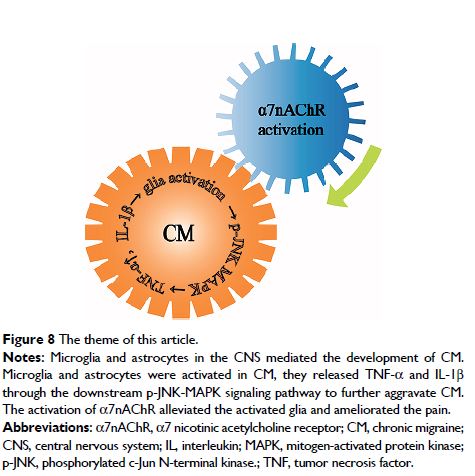108605
论文已发表
注册即可获取德孚的最新动态
IF 收录期刊
- 3.4 Breast Cancer (Dove Med Press)
- 3.2 Clin Epidemiol
- 2.6 Cancer Manag Res
- 2.9 Infect Drug Resist
- 3.7 Clin Interv Aging
- 5.1 Drug Des Dev Ther
- 3.1 Int J Chronic Obstr
- 6.6 Int J Nanomed
- 2.6 Int J Women's Health
- 2.9 Neuropsych Dis Treat
- 2.8 OncoTargets Ther
- 2.0 Patient Prefer Adher
- 2.2 Ther Clin Risk Manag
- 2.5 J Pain Res
- 3.0 Diabet Metab Synd Ob
- 3.2 Psychol Res Behav Ma
- 3.4 Nat Sci Sleep
- 1.8 Pharmgenomics Pers Med
- 2.0 Risk Manag Healthc Policy
- 4.1 J Inflamm Res
- 2.0 Int J Gen Med
- 3.4 J Hepatocell Carcinoma
- 3.0 J Asthma Allergy
- 2.2 Clin Cosmet Investig Dermatol
- 2.4 J Multidiscip Healthc

α7 烟碱型乙酰胆碱受体介导的、在慢性偏头痛大鼠模型中的抗炎作用可通过减弱胶质细胞活化实现
Authors Liu Q, Liu C, Jiang L, Li M, Long T, He W, Qin G, Chen L, Zhou J
Received 7 December 2017
Accepted for publication 3 April 2018
Published 15 June 2018 Volume 2018:11 Pages 1129—1140
DOI https://doi.org/10.2147/JPR.S159146
Checked for plagiarism Yes
Review by Single-blind
Peer reviewers approved by Dr Minal Joshi
Peer reviewer comments 2
Editor who approved publication: Dr Katherine Hanlon
Background: Evidence suggests that the activation of α7 nicotinic acetylcholine
receptor (α7nAChR) can greatly decrease the neuroinflammation response.
Neuroinflammation plays a pivotal role in the pathogenesis of chronic migraine
(CM). Clinical observations also show that nicotine gum induces analgesic
effects in migraine patients. However, whether α7nAChR is involved in CM is
unclear.
Objective: To investigate the role of α7nAChR in CM and provide a new therapeutic
target for CM.
Materials and
methods: Thirty-six male Sprague–Dawley
rats were distributed randomly into control, CM, PNU-282987, and α-bungarotoxin
groups (n=9 rats in each group). The CM model was established by the recurrent
daily administration of inflammatory soup on the dura over the course of 1
week. The hind paw threshold and facial allodynia were assessed by the von Frey
test. The expression levels of α7nAChR, tumor necrosis factor-alpha, and
interleukin-1 beta were analyzed by Western blot and real-time fluorescence
quantitative polymerase chain reaction. The location of α7nAChR in the
hippocampus was quantified by immunofluorescence, as well as the microglial and
astrocyte alterations. Changes in the calcitonin gene-related peptide and the
phosphorylated JNK protein among different groups were measured by Western
blot.
Results: We found that the expression of α7nAChR was reduced after repeated
inflammatory soup administration. The increased expression of tumor necrosis
factor-alpha, interleukin-1 beta, and calcitonin gene-related peptide in CM
group were significantly decreased by PNU-282987 and aggravated by
α-bungarotoxin. Moreover, PNU-282987 decreased the numbers of astrocytes and
microglia compared with the numbers in the CM group in both hippocampal CA1 and
CA3 regions. In contrast, α-bungarotoxin activated the astrocytes and
microglia, but the differences with respect to the CM group were not
significant. Activated c-Jun N-terminal kinase signaling was observed in CM
rats and was also blocked by PNU-282987.
Conclusion: The activation of α7nAChR increased the mechanical threshold and
alleviated pain in the CM rat model. α7nAChR activation also decreased the
upregulation of astrocytes and microglia through the p-c-Jun N-terminal
kinase–mitogen-activated protein kinase signaling pathway.
Keywords: chronic migraine, α7nAChR, analgesia, glial activation,
neuroinflammation, nociception
